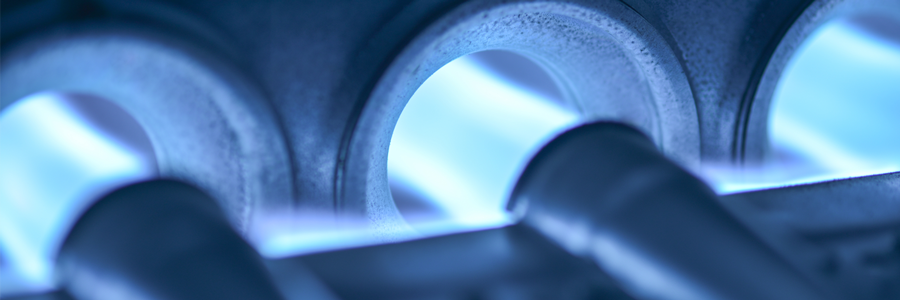
When the outdoor temperatures drop, you want a home that is cozy and comfortable inside! Yet, if you are like most people, you also want an energy-efficient heating option that can provide long-term energy bill savings! Forced-air gas furnaces are available in high-efficiency options that may provide the efficiency and savings that you are looking for from your central heating system.
What is a Forced-Air Gas Heating System?
A forced-air gas heating system uses natural gas or propane as its energy source to heat your home’s indoor air:
- If your home is heated by a forced-air gas furnace system, your equipment may be located in the basement, attic, crawl space or utility closet.
- Natural gas or propane is used to create heat within the furnace’s heat exchanger.
Air from the home's ductwork is blown over the heat exchanger, warming the air as it moves across. - The furnace's blower then forces the heated air into the supply ductwork, distributing it throughout the home.
Factors of Efficiency
Each gas furnace model has an energy efficiency rating in the form of a percent. This number is its Annual Fuel Utilization Efficiency (AFUE), or the ratio of annual heat output of the furnace compared to the amount of annual fuel energy it consumes.
For example, if a furnace has an AFUE of 80%, it means 80% of the energy in the fossil fuel is being converted to heat while 20% escapes and is wasted.1 Today’s high-efficiency systems can have an AFUE as high as 98.5%, meaning nearly all the energy purchased is used for heating your home.
A furnace with a variable speed indoor blower motor can operate at different capacities to more accurately control the heated air flow to your home. This energy-saving feature may save you money on utility bills compared to single-stage furnaces because the system doesn’t have to run at full capacity to reach the set temperature.
How Can AFUE Save on Energy Costs?
Many older furnaces may have efficiencies of less than 70% AFUE, which can cost the homeowner more to heat their home compared to a higher AFUE model.1 Switching to a newer, more energy-efficient gas furnace that can reach upwards of 98% AFUE means nearly all of the energy from the fuel is effectively used to heat the home.1 As a result, the homeowner’s monthly heating bills can be reduced.
Current energy efficiency standards vary by region. To determine your minimum standard, check with your local, licensed professional HVAC dealer.
Types of Gas Furnaces
The gas furnaces available in North America can be put into two categories based on specific venting parameters: condensing and non-condensing.
- Non-Condensing Gas Furnace: A mid-efficiency furnace (80% and 90% AFUE) vents exhaust gases out of the home, typically through the roof.
- Condensing Gas Furnace: A high-efficiency furnace (90% AFUE or higher) utilizes a second heat exchanger to heat the air from condensed exhaust gases in order to reach higher efficiencies. A high-efficiency condensing furnace requires specialized venting.
Homeowners can also install a system with a modulating feature. A modulating gas furnace continuously regulates the amount of fuel burned to maintain the set temperature of your thermostat. This modulating component may minimize indoor temperature fluctuations.
Choosing a Furnace
The initial cost of a high-efficiency condensing furnace may be more expensive than a less efficient model. According to The Department of Energy, homeowners will likely save more money on fuel bills over the life of a higher AFUE product when compared to a lower AFUE or less efficient gas furnace.1 However, when determining if a higher-efficiency furnace is cost-effective for your budget, homeowners should evaluate their anticipated length of home ownership to determine how long it would take to recuperate initial costs of a higher AFUE gas furnace. Some questions to consider are:
- Are you currently in your “forever home”?
- How long do you expect your current home to fit your lifestyle?
- Do you plan to sell your home in the near future?
- Would a job change force you to relocate?
A licensed professional gas furnace dealer can assist you in determining whether a higher efficiency gas furnace or a mid-efficiency model is right for your needs.
By Jen (Anesi) Roby, the former Legislative Editor at ACHR NEWS magazine and current Chief Editor for Plumbing & Mechanical. The Air Conditioning, Heating and Refrigeration (ACHR) NEWS is the HVACR contractor’s weekly news magazine and is the industry’s most trusted and utilized direct communications link to the HVACR buyer. www.achrnews.com

1 Furnace and Boilers. (n.d.). Retrieved from Energy.gov: http://energy.gov/energysaver/furnaces-and-boilers